Samsung Galaxy Note 10 Plus Review
Samsung Galaxy Note 10 Plus Review
It's big. It's powerful. It's the Galaxy Note 10 Plus
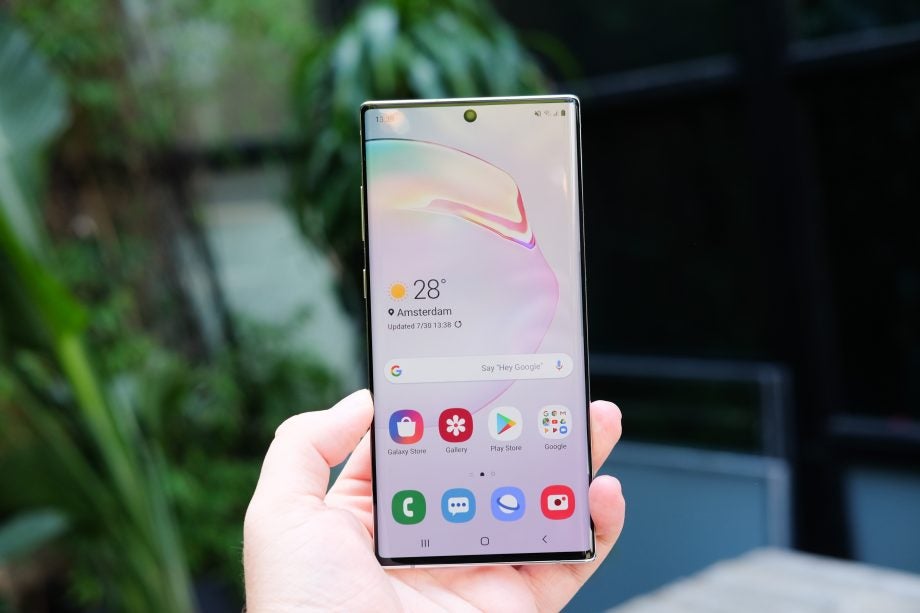
Verdict
The Galaxy Note 10 Plus is the true successor to the Note 9. It’s a brute of a phone with a lovely display, plenty of grunt and a huge battery. There isn’t a whole lot new when compared to the S10 – but this still stands as the true high-end Samsung phone for the end of 2019. It also remains between this and the OnePlus 7 Pro for best big phone around. The Note 10 Plus has more features than the OnePlus – Qi charging, water-resistance, included USB-C buds – but I do love the 90Hz screen on the 7 Pro. Plus it’s notably cheaper than Samsung’s efforts.
Pros
- Lovely big screen
- Very quick to charge
- S Pen is useful
- Versatile cameras
Cons
- Camera isn’t quite up there with the best
- Dodgy Live Video bokeh mode
- 65w charger not included
Key Specifications
- Review Price: £999
- 12MP, 16MP (wide) and 12MP (tele) rear cameras
- 6.8-inch QHD+ AMOLED display
- 256, 512GB storage + microSD
- 4300mAh, 25w charging
- 10MP front camera
- 12GB RAM
Samsung broke the mould with this year’s Note launch, unveiling two devices where before it’s only ever released one. The Note 10 is the smaller, more affordable option, while the Galaxy Note 10 Plus is the company’s true flagship phablet for 2019.
As its name suggests, similarly to the S10 series from earlier in the year, the Plus is a larger, more feature-packed take on the standard Note 10, complete with optional 5G. It will continue to be one of Samsung’s flagship devices even after the rumoured launch of the Samsung Galaxy S20 and Samsung Galaxy S20 Ultra.
This is a great phone and one of the finest all-round Android devices I have reviewed this year. It’s powerful, has just about every feature going and doesn’t skimp at all. It’s big – though you should already know this if you’re even considering a Note – and expensive, but if you want the best of the best there isn’t much better out there.
- For hands-on impressions of Samsung’s latest, delve into our Galaxy Note 20 Ultra review
How much does the Galaxy Note 10 Plus cost?
The Samsung Galaxy Note 10 Plus is available to buy right now. In the UK (among other markets) you have the option of a 256GB model that sells for £999 ($1099.99 in the US), while the 512GB model unveiled at the phone’s launch isn’t yet confirmed for British shores but is up for grabs for $1199.99 Stateside.
There’s also the matter of the 5G model, which is currently a $1299 Verizon exclusive in the US. In the UK it starts at £1099 (for the 256GB model) and costs £1199 for the higher capacity 512GB SKU.
- Read our Samsung Galaxy Note 10 review
Camera – The same array as the Galaxy S10 5G with four sensors on the back
Whereas the Note series might have once given us a glimpse of what was to come in the next big Galaxy S phone, now it’s more of a case of using what’s already there. The camera array on the back of the Note 10 Plus has been plucked straight from the Galaxy S10 and while it remains an excellent camera, it’s not quite on the same level as the iPhone 11 Pro or Huawei P30 Pro.
On the back of the Note 10 Plus there are three cameras, plus a ToF (time of flight) sensor: a main 12-megapixel sensor with an aperture that’ll shift between f/1.5 and f/2.4 depending on the conditions, a 16-megapixel ultra-wide f/2.2 and a 12-megapixel f/2.1 telephoto.
That ToF sensor is used to more accurately measure depth and Samsung seems to use it pretty much exclusively in the new AR stickers mode. This fun, if slightly gimmicky, addition lets you draw over the top of people’s faces with the S Pen and have those doodles stay attached even when the people moves around.
Related: What is a ToF camera?
Both the main and telephoto cameras have optical image stabilisation (OIS) – just like they did on the S10 series. There’s also a bigger focus on video here with ‘pro-grade’ video recording (Samsung’s words), ‘super-steady’ stabilisation and an improved video editor. It’s true that the video recording is very good here even if it can’t quite match the quality of the iPhone 11 Pro. One thing that does disappoint is the Live Focus bokeh mode for video. This does a really shoddy job at cutting out around your head, leaving a poor result.
Photos from all three of the rear cameras here are really good and have a very distinctive Samsung look. Colours, especially reds and greens, are super bright and vivid, popping right off the OLED display. Detail is strong too, though if you start to zoom in you can notice some slight overuse of post-processing sharpening giving photos a bit of an unnatural look.
Check out the images below for a closer look at how the zoom, wide and ultra wide cameras compare.

The Night Mode does a good job of boosting colours and light in low light. However there’s plenty of noise and some of the bright areas look a little too bright

A low light shot without the night mode enabled

And the same with the night mode on. It’s certainly brighter

Main camera: Colours and detail are both excellent

And the ultra wide gets you so much in the photo

Detail in the shots is reliably excellent

You can get really close to the subject and retain lots of detail
Samsung Galaxy Note 10 Plus Design – A very big phone with a futuristic design
While Samsung’s Galaxy S series offers mass appeal, the Note line has always catered to a more niche audience. As a result, it allows Samsung to take more risks, most evident by its sheer size.
This phone may be nearing ‘bezel-free’ status, with a screen reaching to the fringes of its borders, but it’s still one of the most sizeable phones I’ve handled – only really comparable to the iPhone 11 Pro Max and OnePlus 7 Pro.
At least it feels fairly light for its size, coming in at 196g as opposed to the 226g iPhone 11 Pro Max.
Related: Best Phones
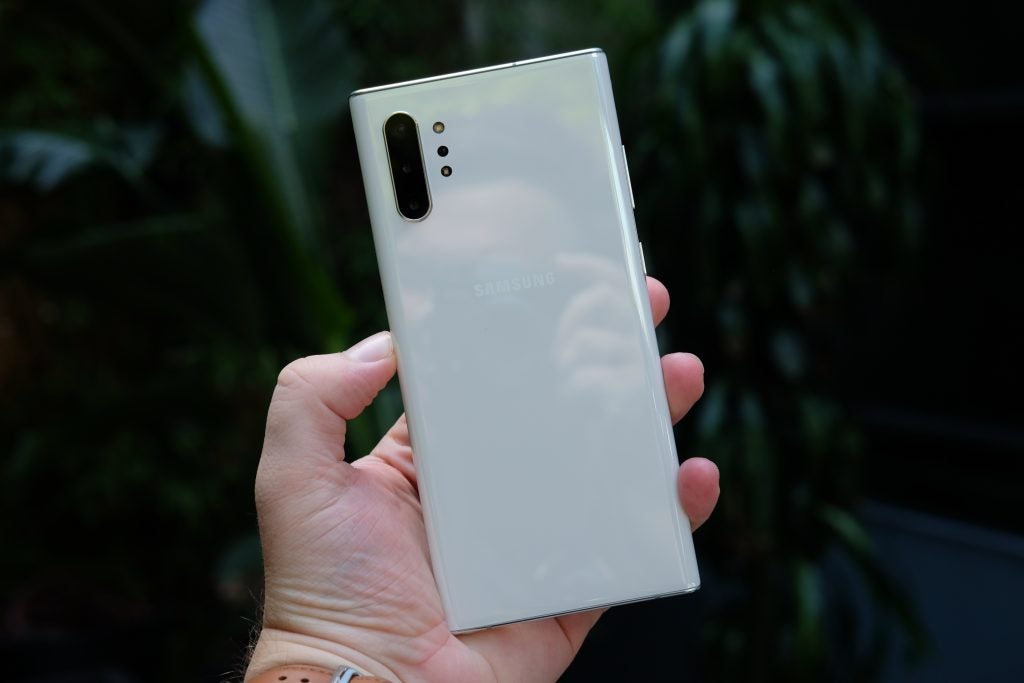
A glass front and back with heavily curved edges meet at a narrow metal frame – the aesthetic is a blend of strength and elegance, helped by keeping the phone well-polished. I’ve been using the flagship – and heavily advertised – Aura Glow model, and it’s quite the looker. The shimmering bluey/silver colour looks different depending on how the light hits it and reminds me a lot of the Huawei P30 Pro. As nice as it does look though, the back remains an absolute fingerprint magnet.
The base of the Note 10 Plus features a USB-C port and room for the S Pen stylus to slot in, however, there’s something missing here.
Samsung has finally ditched the headphone jack from the Note’s design, meaning you’ll have to rely on wireless headphones or a pair with a USB-C connection. There’s a perfectly decent sounding pair of AKG branded USB-C headphones in the box, although there’s no 3.5mm dongle.
Unlike the smaller Note 10, the Note 10 Plus retains a microSD slot for upping the base storage. It’s IP68 rated for water resistance too.
Samsung Galaxy Note 10 Plus Screen – Samsung continues its impressive run of displays
The 6.8-inch display covers the majority of the front of the Note 10 Plus, curving steeply at the sides to give it that all-screen feel. Normally I am against curved displays – it’s the big mark against the OnePlus 7 Pro – but the degree of the curve here is a lot sharper and less distracting than on other phones. There were still some accidental touches though, and the sheer size of the thing makes it difficult to comfortably hold without gripping it with two hands.
While the display is fantastic, it doesn’t have any fancy fast refresh-rate tech like the OnePlus 7 Pro. This is a shame, however you’re only really going to notice if you’ve been using that 7 Pro for an extended period. There’s still a small cutout hiding the front camera too, but this is far less distracting than on the S10 and S10 Plus.
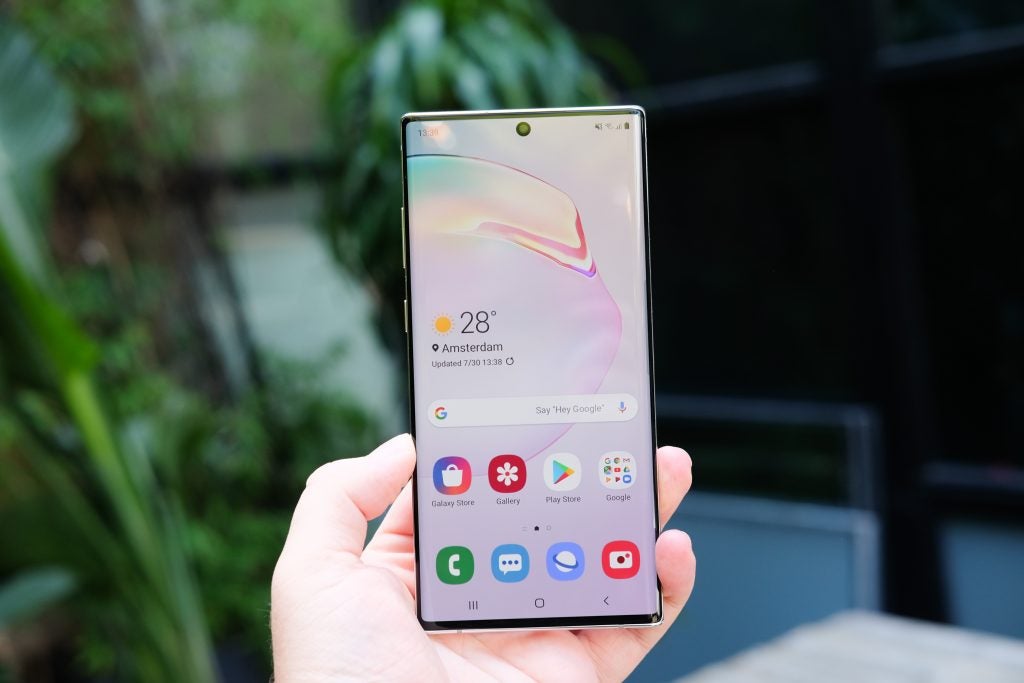
The colours and punch of a Samsung OLED really are still some of the best in the business and the Note 10 Plus display is easily up there with the best displays on the market. It’s a little warmer and a lot more saturated than the screen on the iPhone 11 Pro: reds are richer and whites can be a little yellower. There’s support for HDR10 and HDR10+, with Samsung claiming the AMOLED panel can go above 1000nits. I couldn’t get it to register as such, but that’s likely down to it only boosting it up in certain circumstances.
The 3040 x 1440 resolution remains at the top of what’s available and, to me, it feels like a better choice than upping it to the 4K levels of the Xperia 1.
S Pen and software – The Note 10 Plus has a trick tucked inside and a focus on gaming
The S Pen is the true headline feature for the Note series and it is pretty much the only flagship around that lets you draw and take notes with a pen on the display. It’s a pleasure to write and doodle with, thanks to fantastic responsiveness and excellent palm-rejection.
The S Pen is very much the same as you’d find in a Note 9. It’s packing Bluetooth Low Energy so it can act as a remote for your phone, has a number of new ‘Air Gestures’ for zooming and altering the volume along with improved handwriting recognition. You can also use character recognition to search through notes you’ve handwritten via text.
Like the S10, the Note 10 Plus runs Samsung’s new One UI interface over the top of Android 9. While it’s a big improvement over previous Samsung software, it still lacks some of the finesse of, say, Oxygen OS on a OnePlus 7 Pro.
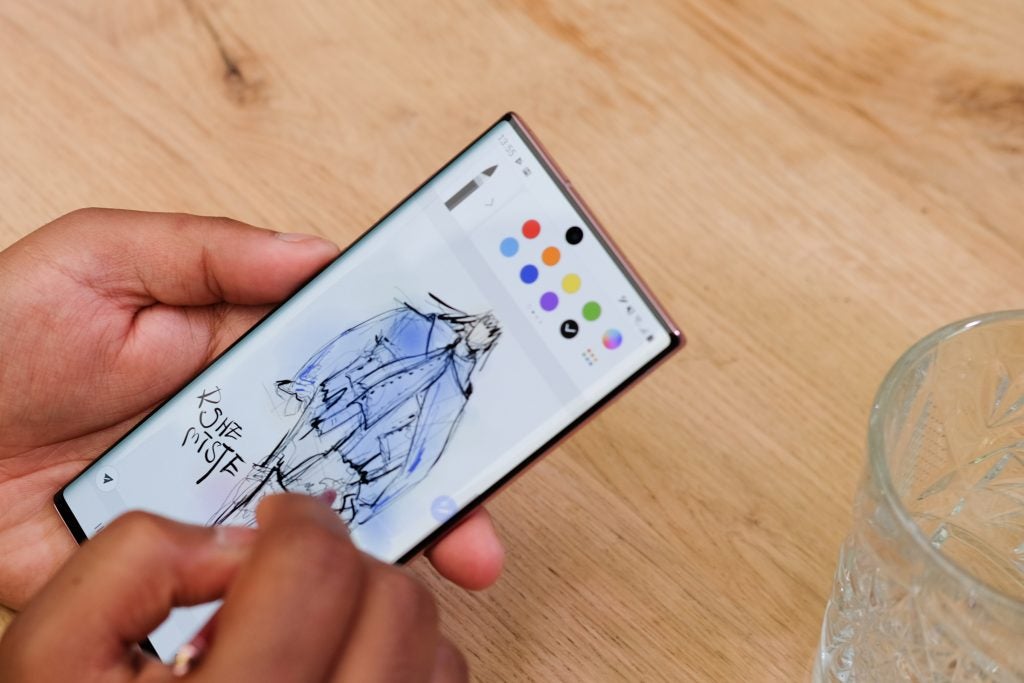
Where One UI does impress is with its focus on making apps easier to use with one hand. With a phone as large as this, it’s good to see more parts of apps – the new message icon, in the SMS app for example – lower down the display, so you’re not stretching your thumb needlessly to the top. Samsung’s multitasking tools are great too, and you can enable a slick dark mode.
So, what’s new for especially Note 10 Plus? For one, you can now plug your device into either a Windows computer or Mac for access to a PC-like DeX UI. This is a nice idea and I really like it for quickly replying to messages and moving photos off the phone. However, the app (on the MacBook Pro I was using to test) is far too unreliable to get anything properly done: individual apps crash, the whole DeX app crashes and the phone becomes disconnected without me actually unplugging it. There is also some new gaming features and the ability to stream games from a compatible PC to the phone.
Performance – The Galaxy Note 10 Plus is one of the most powerful phones around and there’s 5G option
As is usual with Samsung phones, there’s a variety of internals being used. In Europe, it’s the Exynos 9825 which is a slightly more efficient version of the S10’s 9820, while the US gets a Snapdragon version. This is the Snapdragon 855, rather than the slightly faster 855 Plus we’ve seen in a few gaming phones.
Read next: Best Gaming Phones
That chipset has been paired with 12GB RAM and you can pick between 256GB or 512GB of internal storage. It’s great to see Samsung completely ditching meagre levels of storage for such a high-end and expensive phone.
Throughout the near month of using the Galaxy Note 10 Plus I have been consistently impressed by just how fast it feels. Whether it’s gaming, general day-to-day scrolling or slightly more taxing tasks like editing large RAW photos or even cutting up and exporting 4K video, the Note 10 Plus does it all with ease.
As you can see from the benchmarking graphs below, the Note 10 Plus sits below the latest iPhone 11 (and previous iPhone XS) but still pumps out impressive scores.
Rumours before release had suggested the Note 10 Plus would simply be a 5G phone in all its configurations. That’s not the case and you’ll have to pick up a specific version of the Note 10 Plus 5G to benefit.
Audio from this phone is merely ok and this seems to be a side-effect of having basically no room for speakers. The same goes for phone call quality, which can often come across slightly distorted. At least Wi-Fi and cellular strength are excellent.
Related: Best Samsung Galaxy Deals
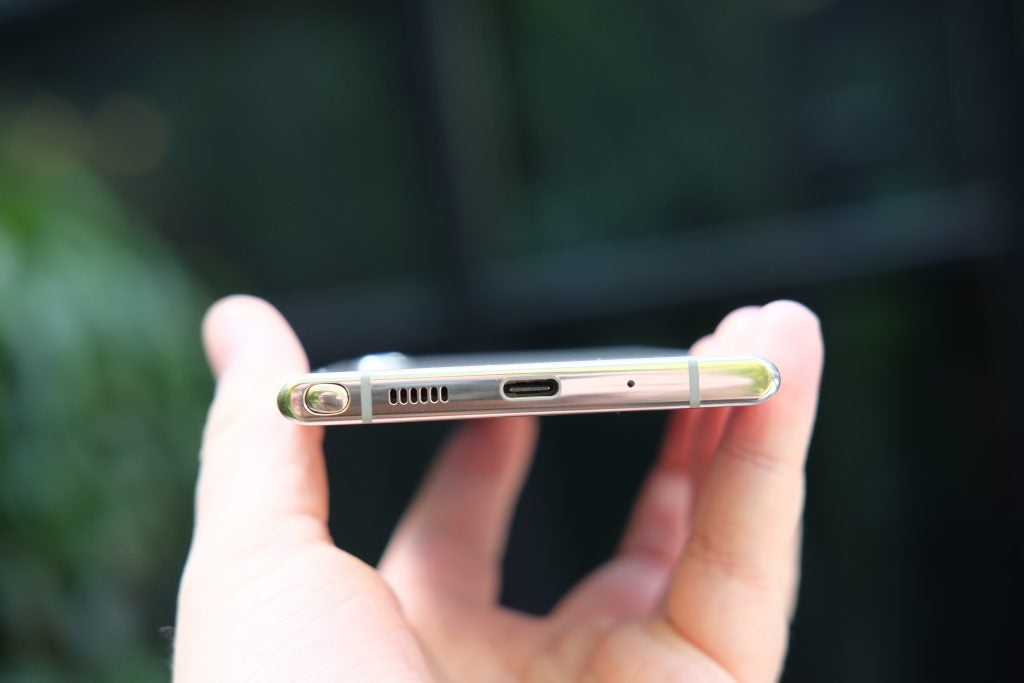
Battery life – The Samsung Galaxy Note 10 Plus will get you through the day, though likely not much more
There’s a 4300mAh battery inside both the Samsung Galaxy Note 10 Plus and its 5G-laden counterpart. Based on the 2019 Galaxy flagship family, this cell capacity is second only to the equally sizeable Samsung Galaxy S10 5G, which packs fractionally larger 4500mAh battery.
Based on the quoted size alone, the Note stands up well against most other flagship phones from the last year, all of which hover around or just above the 4000mAh mark. In practice, I was a little underwhelmed by the phone’s overall longevity, though.
With the phone holding brightness at around 75% for the majority of its use throughout the day, it mustered about 15 hours of uptime with five hours of screen-on time before exhausting itself. This included extensive media streaming, camera usage and a spat of gaming, collectively constituting heavy use, however, rivals like the Huawei P30 Pro, have managed longer screen-on times despite smaller battery capacities.
Separately, I was able to get the Note 10 Plus to deliver two full days of usage, which included 2.75 hours of screen-on time, paired with more considered usage. Out of the box, I had hoped Samsung’s latest powerhouse could manage a comfortable day and a half, but based on the use cases the company has built the phone for, and the demands that such scenarios require, I wouldn’t be confident recommending it for more than a day’s heavy use.
On the recharging side, the Note 10 Plus demonstrates greater versatility. For starters, it boasts convenient wireless charging and retains the S10 series’ Wireless PowerShare reverse wireless charging, which is best used (due to the slowish speeds) for recharging smaller-celled accessories, like the company’s own Galaxy Buds true wireless earphones.
Related: Best true wireless earbuds
I’d like to give Samsung a slap on the wrist for asking people to pay just shy of a £1000 for a smartphone that’s capable of impressive 45W fast charging but only including a 25W power adapter in-box, however, in real-world use, the Note still recharges impressively rapidly.
Using the 25W adapter, the Note 10 Plus consistently refilled in exactly 65 minutes, with a third of the battery full in just 15 and two thirds full after half an hour. Aside from the pleasingly speedy refill of such a large cell, I was pleasantly surprised by the presence of an on-screen charge indicator that includes an impressively accurate charge time counter, so you know just how long you have to wait until the phone is back to full strength.
Should I buy the Samsung Galaxy Note 10 Plus?
The Galaxy Note 10 Plus is the true successor to the Note 9. It’s a brute of a phone with a lovely display, plenty of grunt and a huge battery. There isn’t a whole lot new when compared to the S10 – but this still stands as the true high-end Samsung phone for the end of 2019.
It also remains between this and the OnePlus 7 Pro for best big phone around. The Note 10 Plus has more features than the OnePlus – Qi charging, water-resistance, included USB-C buds – but I do love the 90Hz screen on the 7 Pro. Plus it’s notably cheaper than Samsung’s efforts.
Verdict
A fantastic big phone that’s easy to recommend thanks to a lovely screen, versatile cameras and very quick charging.
How we test phones
We test every mobile phone we review thoroughly. We use industry standard tests to compare features properly and we use the phone as our main device over the review period. We’ll always tell you what we find and we never, ever, accept money to review a product.


